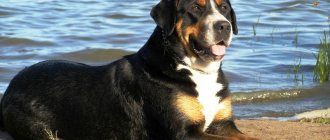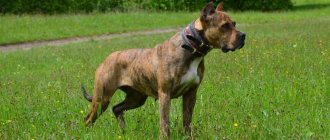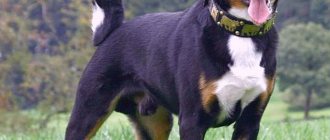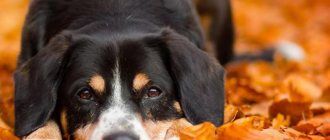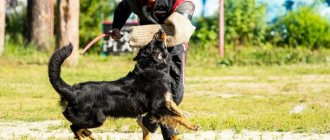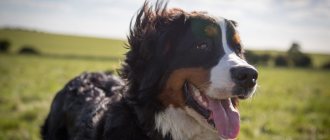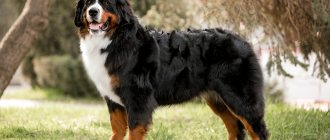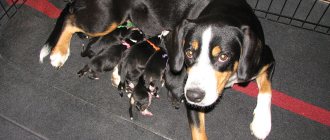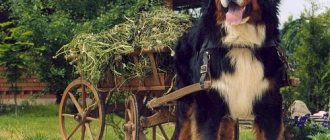The Greater Swiss Mountain Dog, or Grosse, is a calm, noble dog of very large size. In the past, representatives of the breed guarded human homes, herded livestock and carried heavy loads. During World War II, they were harnessed to carry weapons. Nowadays, the Mountain Dog is valued for its attractive appearance, balanced character and versatile working qualities. Let's find out what future owners of this large dog will have to face.
Brief history of origin
The exact history of the origin of the breed is still not known. Researchers have identified two versions of the origin of the Greater Swiss Mountain Dog.
According to the first, the ancestors of the Gross were mastiffs, which came to the Alps along with the Roman legionnaires. Large and intelligent dogs performed military tasks. Over time, their blood mixed with the blood of local shepherd dogs.
According to the second version, Sennenhunds originated from Finnish herding dogs. Central European Great Danes also participated in the formation of the breed. The unusual color of Sennenhunds was formed as a result of an infusion of pinscher blood.
There are 4 varieties of Mountain Dogs:
- big, or gross;
- Bernese;
- entlebucher;
- Appenzeller.
In 1908, the Greater Swiss Mountain Dog participated in the exhibition for the first time. In 1909, Grossies were recognized as a separate breed of dog, and in 1939 the first breed standard was published.
Interesting Facts
- From German "Sennenhund" is translated as an Alpine shepherd.
- Many publications include Mountain Dogs among the ten most beautiful dog breeds in the world.
- Sennenhunds are versatile breeds. They can act as service dogs, be guide dogs, guard homes, herd sheep and be wonderful companions.
- Greater Swiss Mountain Dogs love water. They are excellent swimmers.
- Sennenhunds treat the weakest members of the family with special reverence: they protect women and children with great tenacity and willingness.
Breed description, standards and appearance
The height of females is 60–68 cm, the height of males: 65–72 cm. The weight of males ranges from 50 to 64 kg, and females from 48 to 54 kg.
The first description of the Greater Swiss Mountain Dog breed was published on February 5, 1939.
Now the breed's conformation standard is as follows:
- The skull is wide and flat.
- Lips fit tightly, not sagging; have black pigmentation. Scissor bite.
- The nose is black.
- The eyes are set far away. The color of the iris ranges from light brown to dark brown.
- The ears are triangular in shape and set high. When at rest they lie on the cheekbones.
- The length of the body is greater than the height at the withers. The neck is strong and muscular. The back is straight. The loin is wide. The stomach and sides are slightly tucked.
- When at rest, the tail hangs down and reaches the stinging joint. When excited, the tail should not curl over the back.
- Limbs are straight. The forelimbs are parallel, and the hind limbs are slightly spaced.
The Greater Mountain Dog is a smooth-haired dog. The coat consists of medium-length guard hair and short, dense undercoat. The color is tricolor: on a black background there are spots and markings of white and red. A white mark on the head forms a dent between the eyes.
The dog's chest and bottom of its paws are also painted white. Red spots above the eyes, on the chin, chest, paws and under the tail.
The appearance of these dogs
This is a large dog, with strong, heavy bones, and physically strong. It is one of the largest representatives of mountain herding breeds. According to the standard, height can reach 72 cm, weight – 60 kg. But despite this, the Greater Swiss Mountain Dog is an agile, agile dog, beautiful and harmoniously built.
Head
The head is large, proportional to the body, wedge-shaped, gradually tapering towards the nose. The length of the muzzle is equal to the length of the skull. The forehead is wide, the stop is almost invisible. The jaws are powerful, the lips are tightly fitting and black. Scissor bite. The bridge of the nose is smooth, the lobe is large, protrudes strongly forward, and is well pigmented.
The eyes are almond-shaped, medium-sized, wide-set. Color – all shades of brown. The look is smart and attentive. The ears are triangular, with rounded tips, set high. They usually hang down and lie close to the head. When the dog is concentrated, they turn forward.
Body type
The physique is strong, rectangular in shape. The neck is muscular, without dewlap. The withers are pronounced, the back is straight. The chest is oval, deep. The stomach is slightly tucked, the croup is sloping. The tail is thick, continues the line of the back, hangs down to the hock joint. The dog usually lifts it up, but does not twist it into a ring.
Limbs
Limbs are straight and muscular. The front ones are wider apart than the rear ones. Elbows pressed to chest. The paws are compact, the toes are collected. Despite the large build, the dog’s gait is light and graceful.
Coat and color
The coat is short, rather hard, and lies tightly to the body. The undercoat is thick and dense. According to the standard, the color of the Greater Swiss Mountain Dog can only be tricolor. The colors are bright, the boundaries between them are clear.
The main part of the body is black. Red tan markings on the front of the limbs, on the cheekbones, chest, and underside of the tail. They are located symmetrically. A characteristic feature of the breed is the red markings above the eyebrows. White spots should be located on the chin, neck, chest, tips of the paws and tail. There is a characteristic T-shaped white marking on the muzzle.
Photos complement the description of the appearance:
Character and behavior
Greater Swiss Mountain Dogs are sanguine in nature. Despite their menacing appearance, dogs of this breed almost never show aggression. They are good-natured and loving towards their “pack”.
Grosses treat strangers with caution and arrogance, so they can become excellent guards.
Greater Swiss Mountain Dogs are emotional. They love to have fun and play with pleasure. They perfectly understand their size, and therefore are careful and attentive in the game.
The Greater Swiss Mountain Dog has a special relationship with its owner. Representatives of this breed will always try to please the leader. They need constant attention and have a hard time with long separation from their owner. Grosses are strongly attached to other family members and take them under their wing, especially the weak ones.
However, sometimes the Swiss can be stubborn: they refuse to follow commands or become capricious. This deficiency can be eliminated by teaching the dog discipline.
It is important! The Greater Swiss Mountain Dog has a loud and strong voice, which he does not always use to his advantage. Therefore, the dog is weaned from barking for no reason from childhood.
Sennehunds and children
Great Swiss Mountain Dogs love children. They can act as a nanny: make sure that the baby is not offended, that he is not injured. However, it is worth considering the large size of the dog.
Although Grosses are very careful and do not want to cause injury to anyone, they are capable of accidentally crushing a child.
Attitude towards other animals
Greater Swiss Mountain Dogs are usually indifferent to other pets. They don’t show much love, but they won’t offend either. They can be kept with other dogs.
You should be careful when breeding two males of this breed: they may begin to sort things out. Mountain dogs react negatively to street cats and other animals. Therefore, it is better to take your dog for a walk on a leash.
Character of the breed
The Greater Swiss Mountain Dog is a calm, kind, balanced dog. With proper upbringing, he never shows aggression or strives to dominate. Moderately active, playful, loves to run and play. These dogs have strong innate working qualities. They try to “shepherd” everyone, gather them together, take all the small and weak under their wing. They love to ride children on sleds or in carts and carry bags.
They will guard the house and the plot, as they are vigilant, careful, and self-confident. They have a great sense of their territory. But they lack aggression for guard duty. This is a kind, peace-loving dog; dog handlers do not recommend baiting it or training it as a guard.
Greater Swiss Mountain Dogs are people oriented. They are very attached to their owner and are loving. They remain devoted to their family until the end of their lives. They try to constantly be nearby, participate in all activities, help and fulfill the owner’s requests. They get very bored when they are apart. The dog is wary of strangers, but if he understands that this is a friend, he will be friendly.
These dogs are excellent nannies. They love children, protect and protect them. They tolerate any children's pranks. The dog will never deliberately offend a child, but due to its large size it can accidentally push and drop it.
Grosses are characterized by the following character traits:
- curiosity;
- vigilance;
- equilibrium;
- devotion;
- friendliness;
- equanimity;
- stubbornness.
Features of education and training
Greater Swiss Mountain Dogs are intelligent, quick-witted dogs. They are easy to train, quickly understand what is required of them, and try to please their owner. They can easily learn different tricks and can participate in agility and canicross. The main thing is to immediately show yourself as a leader, then the dog will obey unquestioningly.
In adolescence, a gross can be stubborn, especially if he doesn’t like something, and may refuse to follow a command. The owner needs to find an approach to him. The peculiarity of the representatives of the breed is that they mature slowly. Therefore, upbringing needs to be done continuously for up to 2.5-3 years, and the acquired skills must be constantly repeated.
From the first days the puppy appears in the house, you need to start socializing it, accustoming it to its name and place. Be sure to learn the following commands:
- it is forbidden;
- sit;
- stand;
- near;
- ugh;
- lie.
These dogs are docile and not prone to dominance. Therefore, even an inexperienced dog breeder can handle the training. You just need to pay a lot of attention to your pet. Consistency and regularity are important in training. You need to be firm, but not rude. Give commands in a clear voice.
It is recommended to frequently reward your pet for good behavior and following commands. They respond better to affection and love praise. But you can also use treats. You can’t shout at the boss, or even hit him. These dogs are very touchy - they can become withdrawn and refuse to obey.
Representatives of the breed are prone to barking for no reason, and their voice is very loud, so the puppy must be weaned off this immediately. Another feature is that Grosses are quite loving, they love to jump on their owner’s chest, put their paws on their shoulders or climb onto their owner’s knees. This habit must be eradicated from an early age. It is also important to remember that these dogs mature late and may have problems with toilet training. Therefore, at six months the pet can still make puddles at home. You shouldn't hit him for this or punish him too much.
How to choose the right puppy?
Grossies are the rarest breed of Sennenhunds. In Russia there are only a few nurseries that breed Greater Swiss Mountain Dogs. When buying a puppy, these are the ones you should give preference to. Official nurseries guarantee the proper maintenance of pregnant females, as well as the good health of the parents of the puppies.
Buying a baby of a rare breed from your own hands should be done with caution. Often, enterprising sellers pass off ordinary mongrels as representatives of the breed.
The breeder is obliged to provide documents that confirm that the puppy belongs to the breed. Before purchasing, you should look at the conditions in which the dogs are kept. They look at the appearance and behavior of the parents. A stranger should alert them, but dogs should not behave aggressively.
Choose a pet that:
- looks healthy;
- has clear eyes;
- active and not fearful, treats strangers with interest, not fear.
There should be no bald areas or redness on the baby’s skin, and no discharge under the nose or eyes.
When choosing a puppy, they take into account the purpose for which the pet is being purchased. Only a show-class puppy whose external characteristics and character fully comply with the breed standard is suitable for participation in exhibitions. Such a pet will cost at least 50,000 rubles.
A breed-class puppy has minor external defects that will not allow him to win in shows. But such a pet can participate in breeding. Prices for a breed-class puppy start from 35,000 rubles.
A pet-class puppy will not be able to participate in exhibitions or breeding, but he will become a devoted friend and a wonderful companion. A large pet-class Swiss Mountain Dog costs from 25,000 rubles.
How to buy a Greater Swiss Mountain Dog puppy
It is best to buy a puppy from a professional nursery. The Greater Swiss Mountain Dog is quite rare in our country. Therefore, you need to choose a breeder who values his reputation. He must provide all documents: pedigrees, certificates from exhibitions, veterinary certificates. You can find a good kennel at exhibitions or by reading comments on websites about dogs.
The price for purebred puppies in Moscow starts from 35 thousand. If a dog is offered cheaper, there is a risk that it is not purebred or is sick. Show class puppies are more expensive - from 80 thousand rubles.
Before purchasing, you need to visit the nursery, study the living conditions of the animals, the appearance and behavior of the mother. Then meet the puppies. A healthy baby has the following qualities:
- active, cheerful, inquisitive;
- does not show cowardice or aggression;
- well-fed, but not fat;
- stands confidently on his paws;
- eyes are clear, without discharge;
- nose wet and cold;
- The coat is smooth and shiny, without bald spots.
The photo shows what the puppies should look like:
The video complements the description of the breed:
Video: Greater Swiss Mountain Dog. Breed characteristics, care
Greater Swiss Mountain Dogs are excellent family dogs. They have a balanced character and high intelligence. This is a versatile working dog and family pet. He is capable of becoming a best friend, a devoted companion, a vigilant protector or a nanny for a child.
Caring for puppies
A puppy most often appears in a new home when it is 2-3 months old. The baby can already eat solid food and is not so attached to his mother. Until the second vaccination, the puppy must live indoors without the possibility of going outside. Its bedding is arranged in a non-passable place, protected from drafts and direct sunlight.
The Greater Swiss Mountain Dog takes a long time to mature: intellectual maturation does not keep pace with the dog’s physical growth. At one year old, the Sennenhund already has the large size of an adult dog, while psychologically it remains a puppy.
A dog becomes fully adult at 2.5 years. This is why toilet training a puppy can take several months. Usually, only by the age of six months do gross cats begin to relieve themselves while walking without any flaws.
A two-month-old puppy needs to be fed 5-6 times a day. The number of meals should be gradually reduced until the baby is one year old.
A puppy can be given cow's milk for up to 4 months. In the future, it is replaced with low-fat fermented milk products.
Breed traits
Breed traits (on a 5-point scale)
| Greater Swiss Mountain Dog (Greater Swiss Mountain Cattle Dog) | |||
| Activity | in the house | 3 | |
| on the street | 4 | ||
| Obedience | training | 3.3 | |
| strangers | 1.8 | ||
| Domination | in family | 2.8 | |
| over dogs | 2 | ||
| Defending your territory | from people | 3 | |
| from dogs | 2.8 | ||
| Sociability | in family | 4 | |
| with strangers | 3.3 | ||
| with dogs | 3.3 | ||
| Concentration | in family | 1.5 | |
| in front of strangers | 2.3 | ||
| with dogs | 2 | ||
| Aggressiveness | in family | 2 | |
| to strangers | 1.5 | ||
| to the dogs | 1.8 | ||
| to cats | 2 | ||
| Family behavior | calmness | 2.5 | |
| demand for affection | 3.8 | ||
| excitability | 3 | ||
| playfulness | 3.8 | ||
| excessive barking | 3 | ||
| behavioral breakdowns | 2.3 | ||
| Tolerance for children | up to 4 years | 3.8 | |
| over 4 years old | 3.8 | ||
| Institutional use | watchman | 3.8 | |
| bodyguard | 1 | ||
This breed is often compared to the following dog breeds: Samoyed, German Shepherd, Hovawart, Bernese Mountain Dog, Canaan Dog.
The photographs show what these dogs look like:
Care and maintenance of an adult dog
The Greater Swiss Mountain Dog is easy to care for. Gross has an impressive size, so it is not suitable for keeping in an apartment.
It is also undesirable to put the Gross on a chain or constantly keep it in an enclosure. It is best if the dog has free access to a large plot of land.
Expert opinion
Leonid Rodin
Experienced dog breeder
Ask a Question
The Greater Mountain Dog is the largest of the Swiss dog family. It is growth problems that cause the owners of these dogs the most serious trouble. The fact is that the bones and ligaments of a mountain dog in the first 1.5 years cannot reliably control its weight - the dog grows much faster than the backbone is formed. This results in too much stress on the spine, cartilage and joints. If you let things take their course and do not pay enough attention to your pet, then everything can end very badly. Under no circumstances should the dog be allowed, for example, to go down the stairs on its own. And when walking, you need to make sure that she doesn’t jump off any hills. The above applies only to the downward movement - to stimulate the strengthening of the musculoskeletal system, it is useful for the mountain dog to rise and jump. So, until the age of 1.5-2 years, the owner will have to carry a huge and - what to hide - heavy dog in his arms up steep steps.
The right diet
In order for your Greater Swiss Mountain Dog to live a long and healthy life, you need to pay attention to your pet's diet. You can feed the Gross with industrial feed or natural food.
Gross is a very large dog, so feeding him is not so easy and not at all cheap.
Industrial feed is ideally balanced and contains all the necessary substances, vitamins and minerals. Preference should be given to super-premium and premium food.
Economy class feeds are made from low-quality raw materials and do not have the required ratio of components, but they do contain flavoring additives.
When feeding natural food, it is important to pay attention to ensuring that the diet is varied and contains the necessary components. The Greater Swiss Mountain Dog cannot be fed from the table. Vitamin and mineral supplements are added to natural foods.
Gross's diet includes:
- 70% animal protein (lean veal, chicken, turkey, high-quality offal).
- Porridge (rice, buckwheat, wheat).
- Vegetables (everything except potatoes) and fruits.
- Boiled sea fish (meat must be separated from bones).
- Fermented milk products (cottage cheese, kefir).
You cannot feed your dog the following foods:
- Sweets.
- Bakery products.
- Smoked meats.
- Pickles.
- Tubular bones.
Walking and physical activity
The Greater Swiss Mountain Dog is a working dog that needs daily walks. The dog must spend at least 2.5 hours outside per day. At the same time, it is not enough to just leisurely walk with your pet along the city streets. Gross needs physical exercise.
The Sennenhund will gladly accompany its owner when playing sports.
It is important! The Greater Swiss Mountain Dog is not afraid of frost, so it does not need to be dressed in winter. But the heat has a bad effect on the health of the gross. Therefore, in hot weather in summer, the pet is walked early in the morning or in the evening.
Training and education
Raising a baby must be done from the moment it arrives with its new owners. You should not drag your dog onto the bed, even if he whines pitifully. From the first days, the puppy must learn the rules of the new home.
The Greater Swiss Mountain Dog is highly intelligent. He quickly learns new commands. Representatives of the breed are not prone to dominance, so even a not very experienced dog breeder will be able to find a common language with them.
However, sometimes grosses are stubborn and refuse to follow commands. In this case, it is necessary to achieve obedience from the dog, otherwise in the future the mountain dog will show character and ignore commands.
During training, reinforcement should be used to a greater extent. You also need to punish the dog, but you shouldn’t shout at him or, especially, hit him.
Greater Swiss Mountain Dogs are very people-oriented, so it is better to use praise rather than food as a reward.
It is important! Sennenhunds are able to jump on their owner's chest for joy. Given the size of the dogs, such a jump could result in injury. The pet is weaned from this habit from childhood.
Care and hygiene
The Greater Swiss Mountain Dog does not have very long hair, but has a thick undercoat. Brush the gross once a week. During shedding, twice a year, the dog is scratched daily.
The Mountain Dog is bathed no more than 3 times a year. But they wash their paws after every walk.
The dog's eyes and ears also need care. Wipe the eyes with a cloth moistened with clean water. Ears are cleaned as they become dirty. To do this, use a regular cotton swab. Since Mountain Dogs are active dogs, their nails usually wear down on their own. But if they have grown a lot, their ends are trimmed with a nail clipper or nippers.
Grosses are prone to the formation of tartar. For prevention purposes, they are given cartilage or special sticks. The dog's teeth are brushed once a week using a special brush and toothpaste. To remove the stone, you should contact your veterinarian.
Vaccinations and susceptibility to disease
The puppy is given the first comprehensive vaccine at the age of 2 months. Within a few days after vaccination, the baby's body temperature may rise.
Revaccination against the same diseases is done after 3 weeks. 10 days after this, the puppy can be released outside. The rabies vaccination is given after all baby teeth have been completely replaced: at 6–8 months.
The next time revaccination is done when the dog is 12 months old. In the future, the Sennenhund is vaccinated annually.
Like other large breeds, the Greater Swiss Mountain Dog cannot boast of longevity. On average, the lifespan of a gross is 8–10 years.
Representatives of the breed are prone to diseases:
- Hip dysplasia. It mainly manifests itself in young dogs during the period of active growth.
- Allergy.
- Eye diseases.
- Oncology.
It is important! Swiss Mountain Dogs are often allergic to strong, pungent odors.
Pros and cons of the breed
| pros | Minuses |
| Balanced character and high intelligence | Inconvenient to keep in an apartment due to its large size |
| Love for children and tolerant attitude towards other pets | Due to its large size, the dog can accidentally crush a person |
| Devotion to your family | Growing up late |
| Innate protective qualities |
The Greater Swiss Mountain Dog is a large dog with high intelligence and a balanced character. Among the Mountain Dogs, the Grossy is the rarest and most difficult to obtain variety.
Their cheerfulness, loyalty, intelligence and attractive appearance have led to the growing popularity of these giants among dog breeders. More and more nurseries are appearing that breed this breed.
The Greater Swiss Mountain Dog is not only a versatile working dog, but also an ideal companion for the family and all its members.
General characteristics of the Greater Swiss Mountain Dog breed
The Greater Swiss Mountain Dog is distinguished by its large size and peaceful nature. This is the rarest and oldest variety of the four species of Mountain Dogs. From German the name of this group of breeds is translated as “Alpine shepherd”.
The Greater Mountain Dog differs from the others in its large size and short, smooth coat. Compared to the popular Bernese Mountain Dogs, he is more emotional and sensitive, shows his feelings more strongly, and is active. This is a working dog that perfectly performs any duties. Other names for the breed are Grosse, Swiss Shepherd or Large Mountain Cattle Dog.
| Options | Characteristic |
| Name | Greater Swiss Mountain Dog (German: Grosser Schweizer Sennenhund) |
| a country | Switzerland |
| group of breeds according to the ICF classification | Pinschers and Schnauzers, Molossians, Swiss Mountain and Cattle Dogs section |
| application | companion, rescuer, shepherd, watchman, bodyguard, guide dog, draft dog |
| life expectancy | 9-12 years |
| height | males 65-72 cm, females 60-69 cm |
| weight | males 50-64kg, females 48-54kg |
| activity | average, walks from 1 to 3 hours per day |
| basic character qualities | good nature, devotion, poise, curiosity |
| attitude towards children | protect, never offend, can be a nanny |
| intelligence | tall, easy to train |
| care | not difficult, although the shedding is strong |
pros
Grosses are unpretentious, they live calmly in any conditions, as long as their beloved owner is nearby. Raising and caring for children does not usually cause problems. Most owners note that these dogs have the following advantages:
- attractive appearance;
- peaceful, calm character;
- high intelligence and quick wit;
- no tendency to aggression;
- devotion and strong attachment to the owner and other family members;
- caring attitude towards children;
- patient attitude towards other pets;
- excellent security qualities;
- cleanliness, no drooling;
- moderately active, not fussy.
Minuses
There are also shortcomings in the content of the gross, but they are mainly related to incorrect content. These features can be a problem:
- due to its large size, it is difficult to keep this dog in a city apartment;
- do not tolerate loneliness well;
- can be stubborn and headstrong;
- heavy shedding twice a year;
- cannot tolerate strong odors;
- Representatives of the breed mature late; up to 2 years of age, the dog behaves like a puppy, and can take a long time to learn to use the toilet outside.
Photos complement the characteristics of these dogs:
